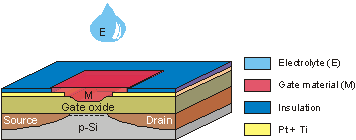Introduction
In view of the increasing interest in our environment, nowadays, measurements of hydrogen peroxide, H2O2, play an important role in environmental, biological and medical fields. A new principle for measuring of hydrogen peroxide using the EMOSFET (Electrolyte Metal Semiconductor Field Effect Transistor) has been developed in the Biosensor group. An important advantage of the sensor based on the EMOSFET structure is the possibility to make miniature low-cost chemical sensors by using IC technology that has been found important for many applications in medicine. A key part of the sensor is a specific layer, gate material, which is deposited on top of the gate oxide of the EMOSFET. This layer is able to take part in a reaction with H2O2 in solution and then transfer the chemical signal to the electrical domain. The hydrogen peroxide concentration can simply be measured by measuring the threshold voltage, VT, of the Field Effect Transistor. The prototype of the EMOSFET based hydrogen peroxide sensor that allows to detect hydrogen peroxide in aqueous solution has been demonstrated.

The EMOSFET structure
Interested?
If you are interested and for instance would like to do your graduation work or practical term, please contact via the email address below.
This project is supported by the Technology Foundation STW in Utrecht, the Netherlands.
